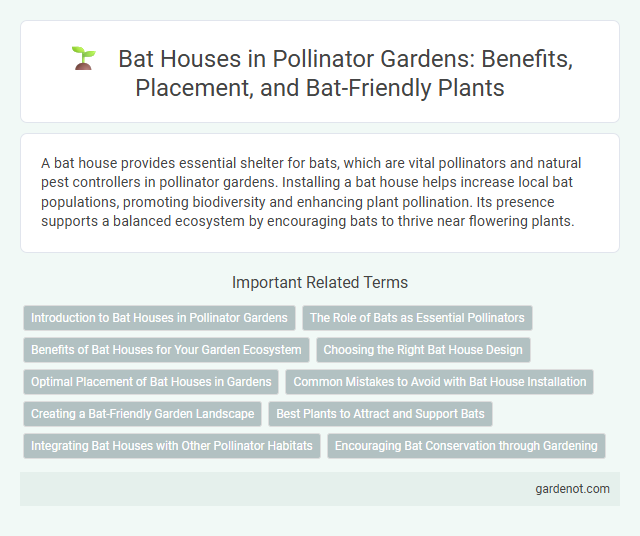A bat house provides essential shelter for bats, which are vital pollinators and natural pest controllers in pollinator gardens. Installing a bat house helps increase local bat populations, promoting biodiversity and enhancing plant pollination. Its presence supports a balanced ecosystem by encouraging bats to thrive near flowering plants.
Introduction to Bat Houses in Pollinator Gardens
Bat houses provide essential roosting sites for bats, which play a crucial role in pollinator gardens by controlling insect populations and facilitating nocturnal pollination. Designed to mimic natural cave environments, these structures offer safe shelter while promoting biodiversity within the garden ecosystem. Incorporating bat houses supports sustainable pest management and enhances the overall health of pollinator habitats.
The Role of Bats as Essential Pollinators
Bat houses provide vital roosting habitats that support bat populations, which act as essential nocturnal pollinators in pollinator gardens. Many bat species facilitate the pollination of night-blooming plants such as agave, durian, and baobab, contributing significantly to biodiversity and ecosystem health. By installing bat houses, gardeners enhance pollination services, promoting plant reproduction and sustaining food webs.
Benefits of Bat Houses for Your Garden Ecosystem
Bat houses provide critical shelter for insectivorous bats, which help control garden pests naturally by consuming large quantities of mosquitoes, moths, and beetles nightly. These nocturnal pollinators contribute to biodiversity by supporting the pollination of night-blooming plants, enhancing the overall health and productivity of your pollinator garden. Installing a bat house promotes a balanced ecosystem, reducing the need for chemical pesticides and encouraging sustainable gardening practices.
Choosing the Right Bat House Design
Choosing the right bat house design is crucial for attracting and supporting local bat populations, which are essential pollinators. Opt for a multi-chambered design with rough interior surfaces to provide bats with ample roosting space and grip. Ensure the house is constructed from durable, untreated wood and mounted at least 12 feet high in a warm, sunlit location to maximize occupancy.
Optimal Placement of Bat Houses in Gardens
Bat houses should be placed in sunny locations receiving at least 6 hours of direct sunlight daily to maintain an optimal temperature range between 80degF and 100degF, ideal for roosting bats. Positioning bat houses 10 to 20 feet above ground and away from bright lights or heavy tree cover enhances bat occupancy and reduces predation risks. Ensuring proximity to water sources and pollinator-friendly plants increases the availability of insects, supporting bats' foraging activities and overall pollination in the garden.
Common Mistakes to Avoid with Bat House Installation
Incorrect placement of a bat house, such as positioning it in shady or low areas, reduces its effectiveness by discouraging bats from roosting. Using inappropriate materials that retain moisture or lack ventilation can lead to mold growth and harm bat populations. Installing bat houses too close to artificial lights or noisy environments disrupts bat activity and limits their pest control benefits.
Creating a Bat-Friendly Garden Landscape
Integrating a bat house into a pollinator garden enhances biodiversity by providing essential roosting habitats for insectivorous bats, which naturally reduce pest populations. Position the bat house in a sunny spot at least 12-15 feet above the ground, avoiding areas with excessive light or wind to ensure a thriving bat colony. Incorporating native flowering plants and water sources supports the bats' food supply, promoting a balanced and sustainable ecosystem within the garden landscape.
Best Plants to Attract and Support Bats
Planting night-blooming flowers such as evening primrose and night-scented stock provides essential nectar sources for bats. Incorporating native fruiting trees like mulberry and elderberry offers vital food and shelter opportunities for bat populations. Tall grasses and dense shrubs create protective roosting habitats, encouraging bats to frequent the pollinator garden.
Integrating Bat Houses with Other Pollinator Habitats
Integrating bat houses with other pollinator habitats enhances ecosystem diversity by providing shelter for nocturnal insect predators that control pest populations harmful to pollinator plants. Placing bat houses near flowering gardens and native plant areas promotes natural pest management while supporting pollinator diversity, such as bees and butterflies. This synergy creates a balanced habitat that fosters robust pollination and sustainable plant growth.
Encouraging Bat Conservation through Gardening
Installing a bat house in a pollinator garden enhances local biodiversity by providing essential roosting habitats for bats, natural predators of many agricultural pests. Bats contribute significantly to pollination and insect control, reducing the need for chemical pesticides and promoting healthier plant growth. Encouraging bat conservation through gardening supports ecosystem balance and fosters sustainable wildlife habitats.
Bat house Infographic

 gardenot.com
gardenot.com